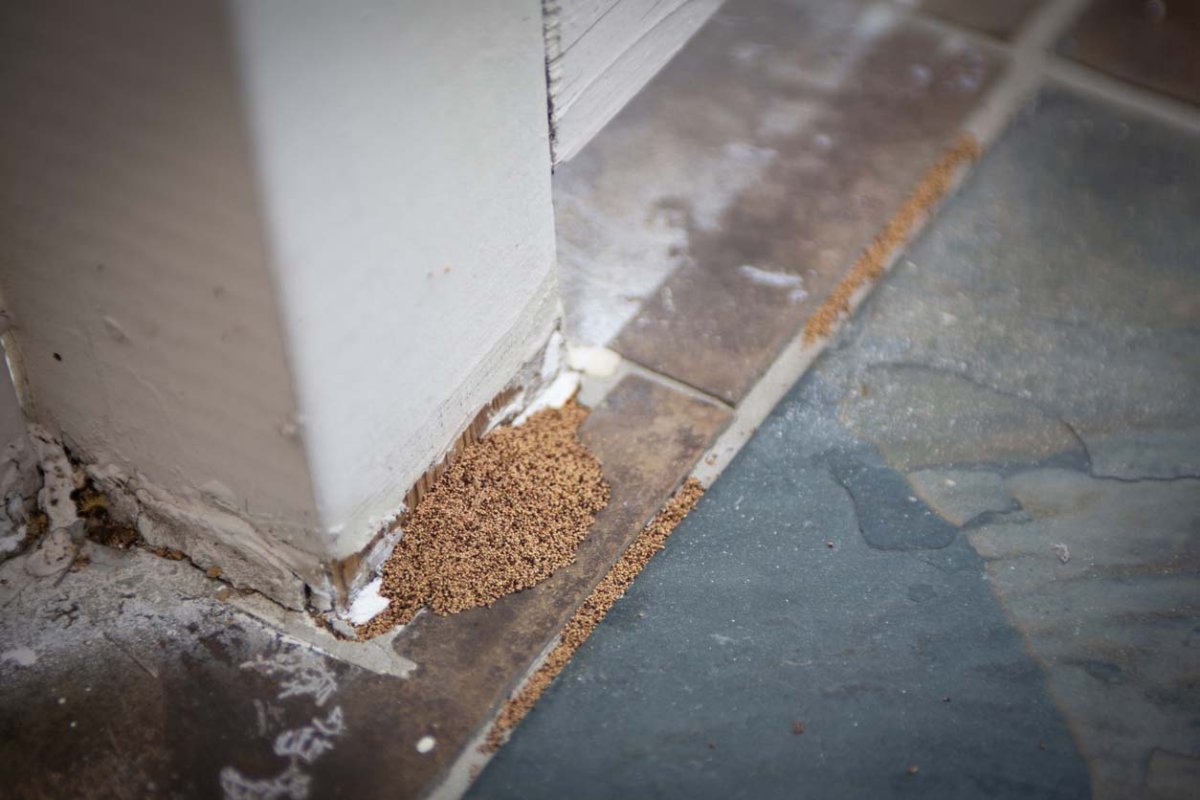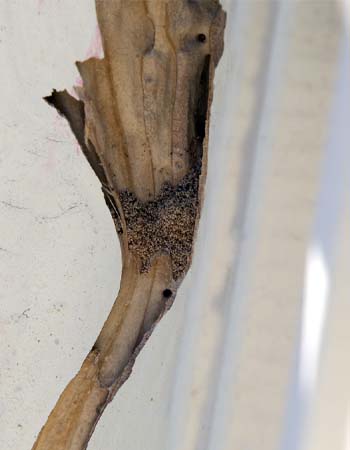

We may earn revenue from the products available on this page and participate in affiliate programs. Learn More ›
Q: Recently I’ve noticed termite droppings but no termitesinside my house. Does this still mean I could have an infestation? What other signs should I look for?
A: Whether spotting termite droppings from the ceiling or frass from termites on a windowsill, any sign of dampwood termites, subterranean termites, or drywood termites can be cause for concern. Since termites are hard to spot, there could be a serious infestation that needs to be handled immediately. Or seeing termite droppings but no termites could indicate there was a previous infestation that’s been eradicated. In either case, it’s wise to look for more signs of termites and reach out to a termite control company to inspect the home and give a full picture of the situation.
Termite droppings, also known as termite frass, are pushed out through kick holes to create more space in the nest.

As termites feed on wood, they break it down into small particles and digest it in their guts. The waste product of this digestion is excreted in the form of tiny termite pellets, also known as frass. These pellets are typically oval or round in shape and vary in color depending on the type of wood the termites have been feeding on.
Although they can sometimes be confused with each other, termite droppings are different in appearance from sawdust or carpenter ant droppings. Sawdust particles look more like shavings or slivers, while carpenter ant droppings are more irregular in size and shape. Termite frass is six-sided and uniform in size. Using a magnifying glass or zooming in with a camera can help to spot the minute differences and determine what insect (if any) is present.
Termites typically live in darkness, so it’s unlikely to see them outside their nests.
Termites often live inside wood or underground, making them even harder to detect. However, if there is a large infestation in a house, the homeowner may notice a few insects here or there. Termites can look like light-colored ants with wings. They’re typically no longer than ¼ inch long and have short, straight antennae without segmentation. Soldier termites have darker heads with black mouths, while worker termites look more like maggots that resemble grains of rice when they move in a colony. It’s also common to see the dropped wings from flying termites that have left the nest.
Seeing termite droppings but no termites might mean that there’s not an active termite infestation, but there was one in the past.
A better-case scenario is that the termite droppings are from a previous infestation and not a current one. This may be the case if someone has recently moved into a home and didn’t have a termite inspection done, as the previous owner may have eliminated an infestation. Or, if the current homeowner previously dealt with termites, there may still be some remnants of their presence.
Whenever termite droppings are spotted, it’s best to have an exterminator look into areas where termites would occupy to confirm that there isn’t still an active infestation. If the droppings are from a previous infestation, an inspection is still beneficial to see if any damage was done and whether it needs to be repaired. While the homeowner may not have to pay for termite treatment, which can cost anywhere from $221 to $916, they may need to have some small repairs done to ensure the home is safe and secure.
Other signs of termites can help confirm an active infestation.
There are several signs of termites beyond droppings to look out for to confirm their presence. One is mud tubes. Subterranean termites build mud tubes to travel between their nest and their food source. These tubes are typically found on the exterior walls of a home and can be a sign of an infestation. Another sign is damaged wood, which can sound hollow or have a honeycomb-like texture since termites feed on the wood. Homeowners may also notice sagging or warped floors, ceilings, or walls, and tight-fitting doors and windows. Clicking sounds in the walls can also indicate an infestation since termites might make clicking or rustling sounds when they are disturbed or moving through wood.
Spotting termite droppings or other signs of an infestation is cause to contact a termite treatment company.
Regardless of how many droppings there are or not seeing actual termites, any small sign of an infestation is worth looking into. The presence of frass indicates that termites have been feeding on and nesting in the wood in or around the home, which can be a serious problem if left untreated. A professional termite control company can inspect the home and property for signs of termites, even if the homeowner can’t see any live insects. They can also determine the extent of the infestation and recommend the right treatment plan for the specific issue. When choosing a termite company, it’s wise to ask about the company’s licensing and certifications, as well as any preliminary steps the homeowner may need to take before an inspection, such as moving furniture or keeping pets out of the area.
Termite damage can be costly to repair, but it’s worth it to ensure a home’s safety.
Depending on how extensive the damage to the home is, termite damage repair costs anywhere from $600 to $3,000. The type of termites, the size of their colony, the amount of damage, and the type of treatment can all affect the final price tag, but the national average is around $1,800. Because termites are hard to remove and can go unnoticed for quite some time, they can carve through drywall, siding, or beams, which can compromise a home’s structural integrity. If any of these areas are damaged, they may need to be replaced.
The best termite treatments range from chemical treatments that are added to the soil, bait systems, heat treatments that help kill termite eggs, and fumigation, and some treatment companies will provide a free inspection if they’re hired to get rid of the problem after.

Termite frass isn’t necessarily dangerous, but it’s still wise to take caution when cleaning it up.
Once the infestation has been treated, any remaining termite droppings should be vacuumed up and disposed of. While termite frass doesn’t often pose a health risk, it’s still wise to wear protective gear when handling termite droppings, since they can contain bacteria and allergens. Protective gear can include gloves, a long-sleeved shirt, and pants to prevent direct contact with the frass. If a homeowner has respiratory issues or is sensitive to dust, it’s wise to wear a mask or respirator.
When vacuuming, it’s best to use one that has a HEPA filter so termite dust and droppings don’t get spread around. Once the droppings have been vacuumed, they can be disposed of in an outdoor trash can with a lid. After this step, it’s best to sanitize the area where the frass was found using a mixture of hot water and disinfectant cleaner.
Homeowners who have experienced infestations will want to protect their homes from future ones.
To keep black termites or red termites from returning, homeowners can employ a number of steps that will protect the home against infestation. They can start by removing any potential food sources, such as firewood, lumber, cardboard boxes, or tree stumps, from the outside or inside of the home. Another method of prevention is to manage the moisture levels in the space, especially in attics or crawl spaces. Since termites are attracted to moisture, it’s wise to regularly check for leaks near pipes or in the basement. Homeowners can also keep an eye out for any termite holes or cracks in their foundation, which can be an inviting place for termites to enter and stay. When in doubt, it may be best to consult one of the best termite control companies, like Terminix or Orkin, for an inspection or treatment.
